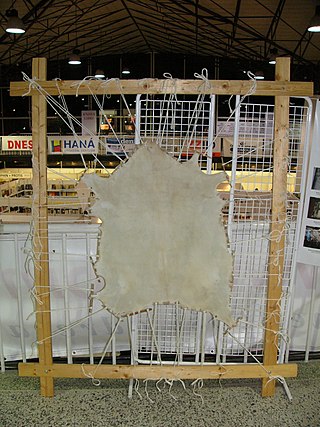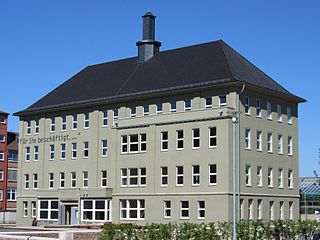
Parchment is a writing material made from specially prepared untanned skins of animals—primarily sheep, calves, and goats. It has been used as a writing medium for over two millennia. Vellum is a finer quality parchment made from the skins of young animals such as lambs and young calves.

Buchenwald was a Nazi concentration camp established on Ettersberg hill near Weimar, Germany, in July 1937. It was one of the first and the largest of the concentration camps within Germany's 1937 borders. Many actual or suspected communists were among the first internees.
Karl-Otto Koch was a mid-ranking commander in the Schutzstaffel (SS) of Nazi Germany who was the first commandant of the Nazi concentration camps at Buchenwald and Sachsenhausen. From September 1941 until August 1942, he served as the first commandant of the Majdanek concentration camp in occupied Poland, stealing vast amounts of valuables and money from murdered Jews. His wife, Ilse Koch, also took part in the crimes at Buchenwald.

Ilse Koch was a German war criminal who committed atrocities while her husband Karl-Otto Koch was commandant at Buchenwald. Though Ilse Koch had no official position in the Nazi state, she became one of the most infamous Nazi figures at war's end.

Ohrdruf was a German forced labour and concentration camp located near Ohrdruf, south of Gotha, in Thuringia, Germany. It was part of the Buchenwald concentration camp network.

Gross-Rosen was a network of Nazi concentration camps built and operated by Nazi Germany during World War II. The main camp was located in the German village of Gross-Rosen, now the modern-day Rogoźnica in Lower Silesian Voivodeship, Poland; directly on the rail-line between the towns of Jawor (Jauer) and Strzegom (Striegau). Its prisoners were mostly Jews, Poles and Soviet citizens.

Georg Konrad Morgen was an SS judge and lawyer who investigated crimes committed in Nazi concentration camps. He rose to the rank of SS-Sturmbannführer (major). After the war, Morgen served as witness at several anti-Nazi trials and continued his legal career in Frankfurt.

Robert Clary was a French actor who was mainly active in the United States. He is best known for his role as Corporal Louis LeBeau on the television sitcom Hogan's Heroes (1965–1971). He also had recurring roles on the soap operas Days of Our Lives (1972–1987), and The Bold and the Beautiful (1990–1992).

Nazi exploitation is a subgenre of exploitation film and sexploitation film that involves Nazis committing sex crimes, often as camp or prison overseers during World War II. Most follow the women in prison formula, only relocated to a concentration camp, extermination camp, or Nazi brothel, and with an added emphasis on sadism, gore, and degradation. The most infamous and influential title is a Canadian production, Ilsa, She Wolf of the SS (1974). Its surprise success and that of Salon Kitty and The Night Porter led European filmmakers, mostly in Italy, to produce similar films, with just over a dozen being released over the next few years. Globally exported to both cinema and VHS, the films were critically attacked and heavily censored, and the sub-genre all but vanished by the end of the seventies.
The Holocaust on your Plate was an exhibition mounted by People for the Ethical Treatment of Animals (PETA) in 2003. It was funded by an anonymous Jewish philanthropist, and consisted of eight 60-square-foot panels, each with a juxtaposition of images of the Holocaust with images of factory farming. Photographs of concentration camp inmates in wooden bunks were shown next to photographs of battery chickens, and piled bodies of Holocaust victims next to a pile of pig carcasses. Captions alleged that "like the Jews murdered in concentration camps, animals are terrorized when they are housed in huge filthy warehouses and rounded up for shipment to slaughter. The leather sofa and handbag are the moral equivalent of the lampshades made from the skins of people killed in the death camps."

Identification of inmates in Nazi concentration camps was performed mostly with identification numbers marked on clothing, or later, tattooed on the skin. More specialized identification in Nazi concentration camps was done with badges on clothing and armbands.
During the 20th century, there were various alleged instances of soap being made from human body fat. During World War I the British press claimed that the Germans operated a corpse factory in which they made glycerine and soap from the bodies of their own soldiers. Both during and after World War II, widely circulated rumors claimed that soap was being mass-produced from the bodies of the victims of Nazi concentration camps which were located in German-occupied Poland. During the Nuremberg trials items were presented as evidence of such production. The Yad Vashem Memorial has stated that the Nazis did not produce soap with fat which was extracted from Jewish corpses on an industrial scale, saying that the Nazis may have frightened camp inmates by deliberately circulating rumors in which they claimed that they were able to extract fat from human corpses, turn it into soap, mass-produce and distribute it.

J. A. Topf and Sons was an engineering company, founded in 1878 in Erfurt, Germany by Johannes Andreas Topf (1816–1891). Originally, it made heating systems and brewing and malting equipment. Later, the company diversified into silos, chimneys, incinerators for burning municipal waste, and crematoria. During World War I it made weapons shells, limbers and other military vehicles. In World War II it also made weapons shells and aircraft parts for the Luftwaffe.

Nazi human experimentation was a series of medical experiments on prisoners by Nazi Germany in its concentration camps mainly between 1942 and 1945. There were 15,754 documented victims, of various nationalities and age groups, although the true number is believed to be more extensive. Many survived, with only a quarter of documented victims killed. Survivors generally experienced severe permanent injuries.
Several individuals and groups have drawn direct comparisons between animal cruelty and the Holocaust. The analogies began soon after the end of World War II, when literary figures, many of them Holocaust survivors, Jewish or both, began to draw parallels between the treatment of animals by humans and the treatments of prisoners in Nazi death camps. The Letter Writer, a 1968 short story by Isaac Bashevis Singer, is a literary work often cited as the seminal use of the analogy. The comparison has been criticized by organizations that campaign against antisemitism, including the Anti-Defamation League (ADL) and the United States Holocaust Memorial Museum, particularly since 2006, when PETA began to make heavy use of the analogy as part of campaigns for improved animal welfare.

Chamber of the Holocaust is a small Holocaust museum located on Mount Zion in Jerusalem, Israel. It was Israel's first Holocaust museum.

There are two notable instances of lampshades made from human skin. After World War II it was reported that Nazis had made at least one lampshade from murdered concentration camp inmates: a human skin lampshade was reported to have been displayed by Buchenwald concentration camp commandant Karl-Otto Koch and his wife Ilse Koch, along with other human skin artifacts. Despite myths to the contrary, there were no systematic efforts by the Nazis to make human skin lampshades.

Goethe Oak, is a name given to a number of oak trees in Germany that are referred to in this way because they allegedly bear some sort of connection to the poet Johann Wolfgang von Goethe.
David Cohen was a soldier in the United States Army and a schoolteacher. In World War II, Cohen was a liberator of the Ohrdruf concentration camp in Nazi Germany as a member of the 4th Armored Division as a radio operator.

A neutral state, the United States entered the war on the Allied side in December 1941. The American government first became aware of the Holocaust in German-occupied Europe in 1942 and 1943. Following a report on the failure to assist the Jewish people by the Department of State, the War Refugee Board was created in 1944 to assist refugees from the Nazis. As one of the most powerful Allied states, the United States played a major role in the military defeat of Nazi Germany and the subsequent Nuremberg trials. The Holocaust saw increased awareness in the 1970s that instilled its prominence in the collective memory of the American people continuing to the present day. The United States has been criticized for taking insufficient action in response to the Jewish refugee crisis in the 1930s and the Holocaust during World War II.















